Seasonality of Relationship between Tropical Cyclone Frequency over the Southern Hemisphere and Tropical Climate Modes
Abstract
1. Introduction
2. Methods
3. Observed Relationship between TC Frequency and Global Circulation
3.1. Comparison of Observed TCF and SST/SSH
3.2. Comparison of Atmospheric Conditions
3.3. Possible Precursors of the SH-TCF Variability
3.4. Long-Term Trend
4. Discussion
5. Conclusions
Funding
Institutional Review Board Statement
Informed Consent Statement
Data Availability Statement
Acknowledgments
Conflicts of Interest
References
- Maldonado, T.; Alfaro, E.J.; Hidalgo, H.G. A review of the main drivers and variability of Central America’s Climate and seasonal forecast systems. Rev. De Biol. Trop. 2018, 66, S153–S175. [Google Scholar] [CrossRef]
- Quesada-Román, A.; Villalobos-Chacón, A. Flash flood impacts of Hurricane Otto and hydrometeorological risk mapping in Costa Rica. Geogr. Tidsskr. Dan. J. Geogr. 2020, 120, 142–155. [Google Scholar] [CrossRef]
- Hidalgo, H.G.; Alfaro, E.J.; HernÃandez-Castro, F.; Pérez-Briceño, P.M. Identification of Tropical Cyclones’ Critical Positions Associated with Extreme Precipitation Events in Central America. Atmosphere 2020, 11, 1123. [Google Scholar] [CrossRef]
- Hidalgo, H.G.; Alfaro, E.J.; Valverde, K.T. Probability of induced extreme precipitation events in Central America due to tropical cyclone positions in the surrounding oceans. Nat. Hazards 2022, 1–17. [Google Scholar] [CrossRef]
- Li, R.; Zhou, W. Revisiting the intraseasonal, interannual and interdecadal variability of tropical cyclones in the western North Pacific. Atmos. Ocean. Sci. Lett. 2018, 11, 198–208. [Google Scholar] [CrossRef]
- Roberts, M.J.; Vidale, P.L.; Senior, C.; Hewitt, H.T.; Bates, C.; Berthou, S.; Chang, P.; Christensen, H.M.; Danilov, S.; Demory, M.-E. The benefits of global high resolution for climate simulation: Process understanding and the enabling of stakeholder decisions at the regional scale. Bull. Am. Meteorol. Soc. 2018, 99, 2341–2359. [Google Scholar] [CrossRef]
- Saji, N.H.; Goswami, B.N.; Vinayachandran, P.N.; Yamagata, T. A dipole mode in the tropical Indian Ocean. Nature 1999, 401, 360–363. [Google Scholar] [CrossRef]
- Ashok, K.; Behera, S.K.; Rao, S.A.; Weng, H.; Yamagata, T. El Niño Modoki and its possible teleconnection. J. Geophys. Res. Ocean. 2007, 112, C11007. [Google Scholar] [CrossRef]
- Chen, G.; Tam, C.-Y. Different impacts of two kinds of Pacific Ocean warming on tropical cyclone frequency over the western North Pacific. Geophys. Res. Lett. 2010, 37, L01803. [Google Scholar] [CrossRef]
- Kim, H.-M.; Webster, P.J.; Curry, J.A. Modulation of North Pacific tropical cyclone activity by three phases of ENSO. J. Clim. 2011, 24, 1839–1849. [Google Scholar] [CrossRef]
- Chiang, J.C.H.; Vimont, D.J. Analogous Pacific and Atlantic meridional modes of tropical atmosphere–ocean variability. J. Clim. 2004, 17, 4143–4158. [Google Scholar] [CrossRef]
- Zhang, W.; Vecchi, G.A.; Murakami, H.; Villarini, G.; Jia, L. The Pacific meridional mode and the occurrence of tropical cyclones in the western North Pacific. J. Clim. 2016, 29, 381–398. [Google Scholar] [CrossRef]
- Gao, S.; Zhu, L.; Zhang, W.; Chen, Z. Strong modulation of the Pacific meridional mode on the occurrence of intense tropical cyclones over the western North Pacific. J. Clim. 2018, 31, 7739–7749. [Google Scholar] [CrossRef]
- Qian, Y.; Murakami, H.; Nakano, M.; Hsu, P.-C.; Delworth, T.L.; Kapnick, S.B.; Ramaswamy, V.; Mochizuki, T.; Morioka, Y.; Doi, T. On the mechanisms of the active 2018 tropical cyclone season in the North Pacific. Geophys. Res. Lett. 2019, 46, 12293–12302. [Google Scholar] [CrossRef]
- Takaya, Y. Positive phase of Pacific meridional mode enhanced western North Pacific tropical cyclone activity in summer 2018. Sola 2019, 15A, 55–59. [Google Scholar] [CrossRef]
- Ogata, T.; Taguchi, B.; Yamamoto, A.; Nonaka, M. Potential Predictability of the Tropical Cyclone Frequency Over the Western North Pacific with 50-km AGCM Ensemble Experiments. J. Geophys. Res. Atmos. 2021, 126, e2020JD034206. [Google Scholar] [CrossRef]
- Ogata, T.; Baba, Y. Variability of tropical cyclone frequency over the western north Pacific in 2018–2020. Front. Clim. 2021, 3, 770785. [Google Scholar] [CrossRef]
- Camargo, S.J.; Emanuel, K.A.; Sobel, A.H. Use of a genesis potential index to diagnose ENSO effects on tropical cyclone genesis. J. Clim. 2007, 20, 4819–4834. [Google Scholar] [CrossRef]
- Kuleshov, Y.; Qi, L.; Fawcett, R.; Jones, D. On tropical cyclone activity in the Southern Hemisphere: Trends and the ENSO connection. Geophys. Res. Lett. 2008, 35, L14S08. [Google Scholar] [CrossRef]
- Xie, S.P.; Annamalai, H.; Schott, F.A.; McCreary, J.P. Structure and mechanisms of South Indian Ocean climate variability. J. Clim. 2002, 15, 864–878. [Google Scholar] [CrossRef]
- Liu, K.S.; Chan, J.C.L. Interannual variation of Southern Hemisphere tropical cyclone activity and seasonal forecast of tropical cyclone number in the Australian region. Int. J. Climatol. 2012, 32, 190–202. [Google Scholar] [CrossRef]
- Vincent, D.G. The South Pacific convergence zone (SPCZ): A review. Mon. Weather. Rev. 1994, 122, 1949–1970. [Google Scholar] [CrossRef]
- Vincent, E.M.; Lengaigne, M.; Menkes, E.M.; Jourdain, N.C.; Marchesiello, P.; Madec, G. Interannual variability of the South Pacific Convergence Zone and implications for tropical cyclone genesis. Clim. Dyn. 2011, 36, 1881–1896. [Google Scholar] [CrossRef]
- Dowdy, A.J.; Qi, L.; Jones, D.; Ramsay, H.; Fawcett, R.; Kuleshov, Y. Tropical cyclone climatology of the South Pacific Ocean and its relationship to El Niño–Southern Oscillation. J. Clim. 2012, 25, 6108–6122. [Google Scholar] [CrossRef]
- Chand, S.S.; McBride, J.L.; Tory, K.J.; Wheeler, M.C.; Walsh, K.J.E. Impact of different ENSO regimes on southwest Pacific tropical cyclones. J. Clim. 2013, 26, 600–608. [Google Scholar] [CrossRef]
- Magee, A.D.; Verdon-Kidd, D.C.; Diamond, H.J.; Kiem, A.S. Influence of ENSO, ENSO Modoki, and the IPO on tropical cyclogenesis: A spatial analysis of the southwest Pacific region. Int. J. Climatol. 2017, 37, 1118–1137. [Google Scholar] [CrossRef]
- Ho, C.-H.; Kim, J.-H.; Jeong, J.-H.; Kim, H.-S.; Chen, D. Variation of tropical cyclone activity in the South Indian Ocean: El Niño–southern oscillation and madden-Julian oscillation effects. J. Geophys. Res. Atmos. 2006, 111, D22101. [Google Scholar] [CrossRef]
- Dowdy, A.; Kuleshov, Y. An analysis of tropical cyclone occurrence in the Southern Hemisphere derived from a new satellite-era data set. Int. J. Remote Sens. 2012, 33, 7382–7397. [Google Scholar] [CrossRef]
- Bjerknes, J. Atmospheric teleconnections from the equatorial Pacific. Mon. Weather. Rev. 1969, 97, 163–172. [Google Scholar] [CrossRef]
- Rasmusson, E.M.; Wallace, J.M. Meteorological aspects of the El Nino/southern oscillation. Science 1983, 222, 1195–1202. [Google Scholar] [CrossRef]
- Kawamura, R. A possible mechanism of the Asian summer monsoon-ENSO coupling. J. Meteorol. Soc. Jpn. Ser. II 1998, 76, 1009–1027. [Google Scholar] [CrossRef]
- Lau, K.M.; Wu, H.T. Principal modes of rainfall–SST variability of the Asian summer monsoon: A reassessment of the monsoon–ENSO relationship. J. Clim. 2001, 14, 2880–2895. [Google Scholar] [CrossRef]
- Ohba, M.; Ueda, H. Basin-wide warming in the equatorial Indian Ocean associated with El Niño. Sola 2005, 1, 89–92. [Google Scholar] [CrossRef]
- Tokinaga, H.; Tanimoto, Y. Seasonal transition of SST anomalies in the tropical Indian Ocean during El Niño and Indian Ocean dipole years. J. Meteorol. Soc. Jpn. Ser. II 2004, 82, 1007–1018. [Google Scholar] [CrossRef]
- Rao, S.A.; Behera, S.K. Subsurface influence on SST in the tropical Indian Ocean: Structure and interannual variability. Dyn. Atmos. Ocean. 2005, 39, 103–135. [Google Scholar] [CrossRef]
- Yokoi, T.; Tozuka, T.; Yamagata, T. Seasonal variation of the Seychelles Dome. J. Clim. 2008, 21, 3740–3754. [Google Scholar] [CrossRef]
- Xie, S.-P.; Hu, K.; Hanfer, J.; Tokinaga, H.; Du, Y.; Du, Y.; Huang, G.; Sample, T. Indian Ocean capacitor effect on Indo–western Pacific climate during the summer following El Niño. J. Clim. 2009, 22, 730–747. [Google Scholar] [CrossRef]
- Behera, S.K.; Luo, J.J.; Masson, S.; Rao, S.A.; Sakuma, H.; Yamagata, T. A CGCM study on the interaction between IOD and ENSO. J. Clim. 2006, 19, 1688–1705. [Google Scholar] [CrossRef]
- Knapp, K.R.; Kruk, M.C.; Levinson, D.H.; Diamond, H.J.; Neumann, C.J. The international best track archive for climate stewardship (IBTrACS) unifying tropical cyclone data. Bull. Am. Meteorol. Soc. 2010, 91, 363–376. [Google Scholar] [CrossRef]
- Kalnay, E.; Kanamitsu, M.; Kistler, R.; Collins, R.; Deaven, D.; Gandin, L.; Iredell, M.; Saha, S.; White, G.; Woollen, J. The NCEP/NCAR 40-year reanalysis project. Bull. Am. Meteorol. Soc. 1996, 77, 437–472. [Google Scholar] [CrossRef]
- Reynolds, R.W.; Smith, T.M.; Liu, C.; Chelton, D.B.; Casey, K.S.; Schlax, M.G. Daily high-resolution-blended analyses for sea surface temperature. J. Clim. 2007, 20, 5473–5496. [Google Scholar] [CrossRef]
- Behringer, D.; Xue, Y. Evaluation of the global ocean data assimilation system at NCEP: The Pacific Ocean. In Proceedings of the Proc. Eighth Symp. on Integrated Observing and Assimilation Systems for Atmosphere, Oceans, and Land Surface, Seattle, WA, USA, 12 January 2004. [Google Scholar]
- Fu, L.-L. Ocean circulation and variability from satellite altimetry. In International Geophysics; Academic Press: Cambridge, MA, USA, 2001; p. 141-XXVIII. [Google Scholar]
- Trenary, L.L.; Han, W. Intraseasonal-to-interannual variability of South Indian Ocean sea level and thermocline: Remote versus local forcing. J. Phys. Oceanogr. 2012, 42, 602–627. [Google Scholar] [CrossRef]
- Gray, W.M. Global view of the origin of tropical disturbances and storms. Mon. Weather. Rev. 1968, 96, 669–700. [Google Scholar] [CrossRef]
- Emanuel, K.; Nolan, D.S. Tropical cyclone activity and the global climate system. In Proceedings of the 26th Conference on Hurricanes and Tropical Meteorology, Miami, FL, USA, 3–7 May 2004. [Google Scholar]
- Matsuno, T. Quasi-geostrophic motions in the equatorial area. J. Meteorol. Soc. Jpn. Ser. II 1966, 44, 25–43. [Google Scholar] [CrossRef]
- Gill, A.E. Some simple solutions for heat-induced tropical circulation. Q. J. R. Meteorol. Soc. 1980, 106, 447–462. [Google Scholar] [CrossRef]
- Emanuel, K.A. The maximum intensity of hurricanes. J. Atmos. Sci. 1988, 45, 1143–1155. [Google Scholar] [CrossRef]
- Vincent, E.M.; Lengaigne, M.; Madec, G.; Vialard, J.; Samson, G.; Jourdain, N.C.; Menkes, C.E.; Jullien, S. Processes setting the characteristics of sea surface cooling induced by tropical cyclones. J. Geophys. Res. Ocean. 2012, 117. [Google Scholar] [CrossRef]
- Ogata, T.; Mizuta, R.; Adachi, Y.; Murakami, H.; Ose, T. Effect of air-sea coupling on the frequency distribution of intense tropical cyclones over the northwestern Pacific. Geophys. Res. Lett. 2015, 42, 10415–10421. [Google Scholar] [CrossRef]
- Ogata, T.; Mizuta, R.; Adachi, Y.; Murakami, H.; Ose, T. Atmosphere-ocean coupling effect on intense tropical cyclone distribution and its future change with 60 km-AOGCM. Sci. Rep. 2016, 6, 29800. [Google Scholar] [CrossRef]
- Ma, Z.; Fei, J.; Huang, X.; Cheng, X. Modulating effects of mesoscale oceanic eddies on sea surface temperature response to tropical cyclones over the western North Pacific. J. Geophys. Res. Atmos. 2018, 123, 367–379. [Google Scholar] [CrossRef]
- Hsu, H.-H.; Hung, C.-H.; Lo, A.-K.; Wu, C.-C.; Hung, C.-W. Influence of tropical cyclones on the estimation of climate variability in the tropical western North Pacific. J. Clim. 2008, 21, 2960–2975. [Google Scholar] [CrossRef]
- Marshall, A.G.; Hemer, M.A.; Hendon, H.H.; McInnes, K.L. Southern annular mode impacts on global ocean surface waves. Ocean. Model. 2018, 129, 58–74. [Google Scholar] [CrossRef]
- Spensberger, C.; Reeder, M.J.; Spengler, T.; Patterson, M. The connection between the southern annular mode and a feature-based perspective on Southern Hemisphere midlatitude winter variability. J. Clim. 2020, 33, 115–129. [Google Scholar] [CrossRef]
- Lubis, S.W.; Hassanzadeh, P. The Intrinsic 150-day Periodicity of the Southern Hemisphere Extratropical Large-Scale Atmospheric Circulation. Authorea Prepr. 2022. [Google Scholar] [CrossRef]
- Stuecker, M.F. Revisiting the Pacific meridional mode. Sci. Rep. 2018, 8, 3216. [Google Scholar] [CrossRef]
- Richter, I.; Stuecker, M.F.; Takahashi, N.; Schneider, N. Disentangling the North Pacific Meridional Mode from tropical Pacific variability. NPJ Clim. Atmos. Sci. 2022, 5, 94. [Google Scholar] [CrossRef]
- Vimont, D.J.; Wallace, J.M.; Battisti, D.S. The seasonal footprinting mechanism in the Pacific: Implications for ENSO. J. Clim. 2003, 16, 2668–2675. [Google Scholar] [CrossRef]
- Chang, P.; Zhang, L.; Saravanan, R.; Vimont, D.J.; Chiang, J.C.H.; Ji, L.; Seidel, H.; Tippett, M.K. Pacific meridional mode and El Niño—Southern oscillation. Geophys. Res. Lett. 2007, 34. [Google Scholar] [CrossRef]
- Ogata, T.; Doi, T.; Morioka, Y.; Behera, S. Mid-latitude source of the ENSO-spread in SINTEX-F ensemble predictions. Clim. Dyn. 2019, 52, 2613–2630. [Google Scholar] [CrossRef]
- Held, I.M.; Soden, B.J. Robust responses of the hydrological cycle to global warming. J. Clim. 2006, 19, 5686–5699. [Google Scholar] [CrossRef]
- Murakami, H.; Wang, Y.; Yoshimura, H.; Mizuta, R.; Sugi, M.; Shindo, E.; Adachi, Y.; Yukimoto, S.; Hosaka, M.; Kusunoki, S.; et al. Future changes in tropical cyclone activity projected by the new high-resolution MRI-AGCM. J. Clim. 2012, 25, 3237–3260. [Google Scholar] [CrossRef]
- Roberts, M.J.; Vidale, P.L.; Mizielinski, M.S.; Demory, M.-E.; Schiemann, R.; Strachan, J.; Hodges, K.; Bell, R.; Camp, J. Tropical cyclones in the UPSCALE ensemble of high-resolution global climate models. J. Clim. 2015, 28, 574–596. [Google Scholar] [CrossRef]
- Yamada, Y.; Kodama, C.; Satoh, M.; Sugi, M.; Roberts, M.J.; Mizuta, R.; Noda, A.T.; Nasuno, T.; Nakano, M.; Vidale, P.L. Evaluation of the contribution of tropical cyclone seeds to changes in tropical cyclone frequency due to global warming in high-resolution multi-model ensemble simulations. Prog. Earth Planet. Sci. 2021, 8, 1–17. [Google Scholar] [CrossRef]
- Quaseda-Roman, A.; Ballesteros-Canovas, J.A.; Guillet, S.; Madrigal-Gonzalez, J.; Stoffel, M. Neotropical Hypericum irazuense shrubs reveal recent ENSO variability in Costa Rican páramo. Dendrochronologia 2020, 61, 125704. [Google Scholar] [CrossRef]
- Baba, Y. Spectral cumulus parameterization based on cloud-resolving model. Clim. Dyn. 2019, 52, 309–334. [Google Scholar] [CrossRef]
- Baba, Y. Influence of a spectral cumulus parametrization on simulating global tropical cyclone activity in an AGCM. Q. J. R. Meteorol. Soc. 2021, 147, 1170–1188. [Google Scholar] [CrossRef]
- Frank, W.M.; Roundy, P.E. The role of tropical waves in tropical cyclogenesis. Mon. Weather. Rev. 2006, 134, 2397–2417. [Google Scholar] [CrossRef]
- Schreck, C.J.; Molinari, J.; Aiyyer, A. A global view of equatorial waves and tropical cyclogenesis. Mon. Weather. Rev. 2012, 140, 774–788. [Google Scholar] [CrossRef]
- Lubis, S.W.; Jacobi, C. The modulating influence of convectively coupled equatorial waves (CCEWs) on the variability of tropical precipitation. Int. J. Climatol. 2015, 35, 1465–1483. [Google Scholar] [CrossRef]
- Feng, X.; Yang, G.Y.; Hodges, K.I.; Methven, J. Equatorial waves as useful precursors to tropical cyclone occurrence and intensification. Nat. Commun. 2023, 14, 511. [Google Scholar] [CrossRef] [PubMed]
- Vecchi, G.A.; Harrison, D.E. Tropical Pacific sea surface temperature anomalies, El Niño, and equatorial westerly wind events. J. Clim. 2000, 13, 1814–1830. [Google Scholar] [CrossRef]
- Seiki, A.; Takayabu, Y.N. Westerly wind bursts and their relationship with intraseasonal variations and ENSO. Part I: Statistics. Mon. Weather. Rev. 2007, 135, 3325–3345. [Google Scholar] [CrossRef]
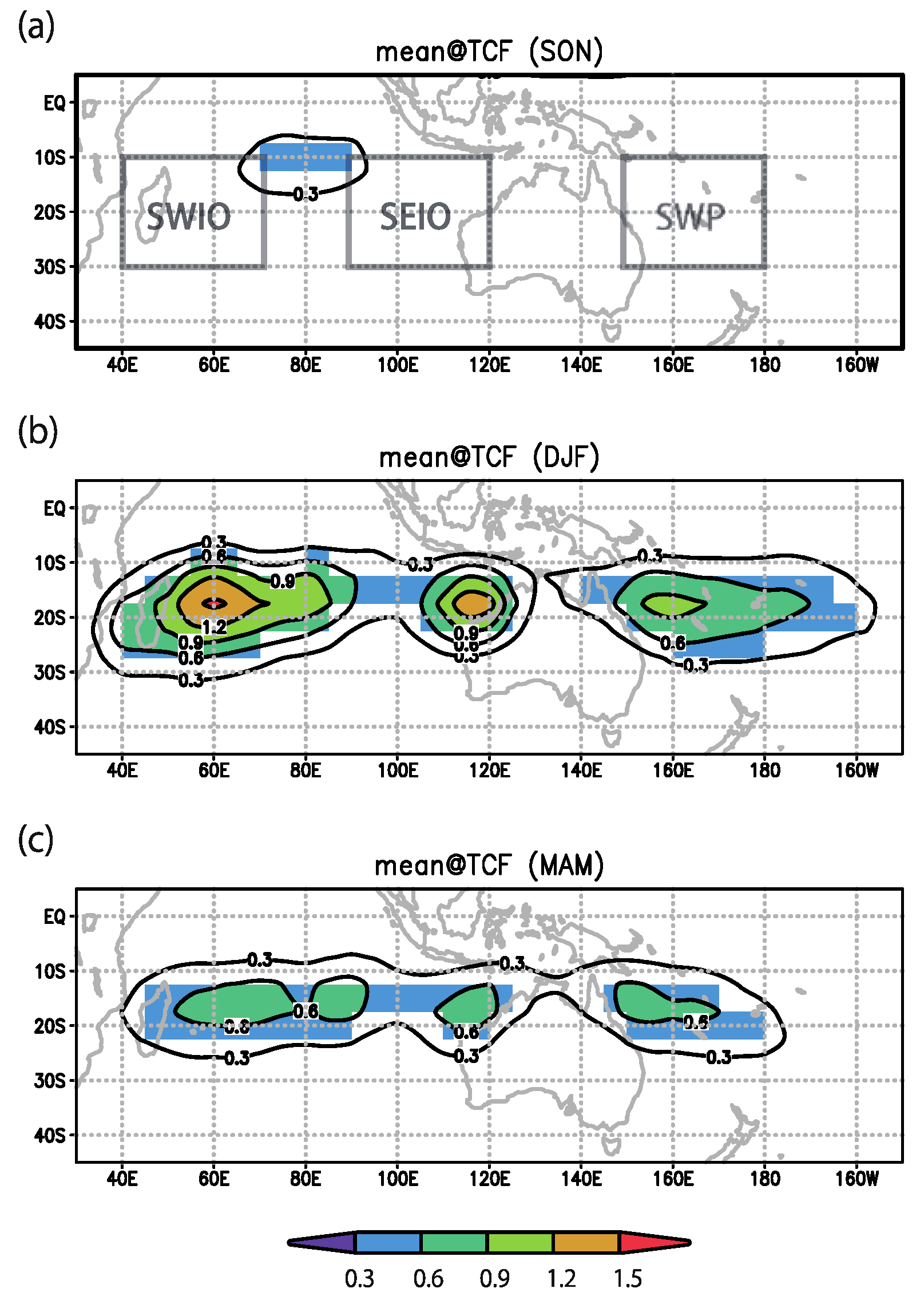

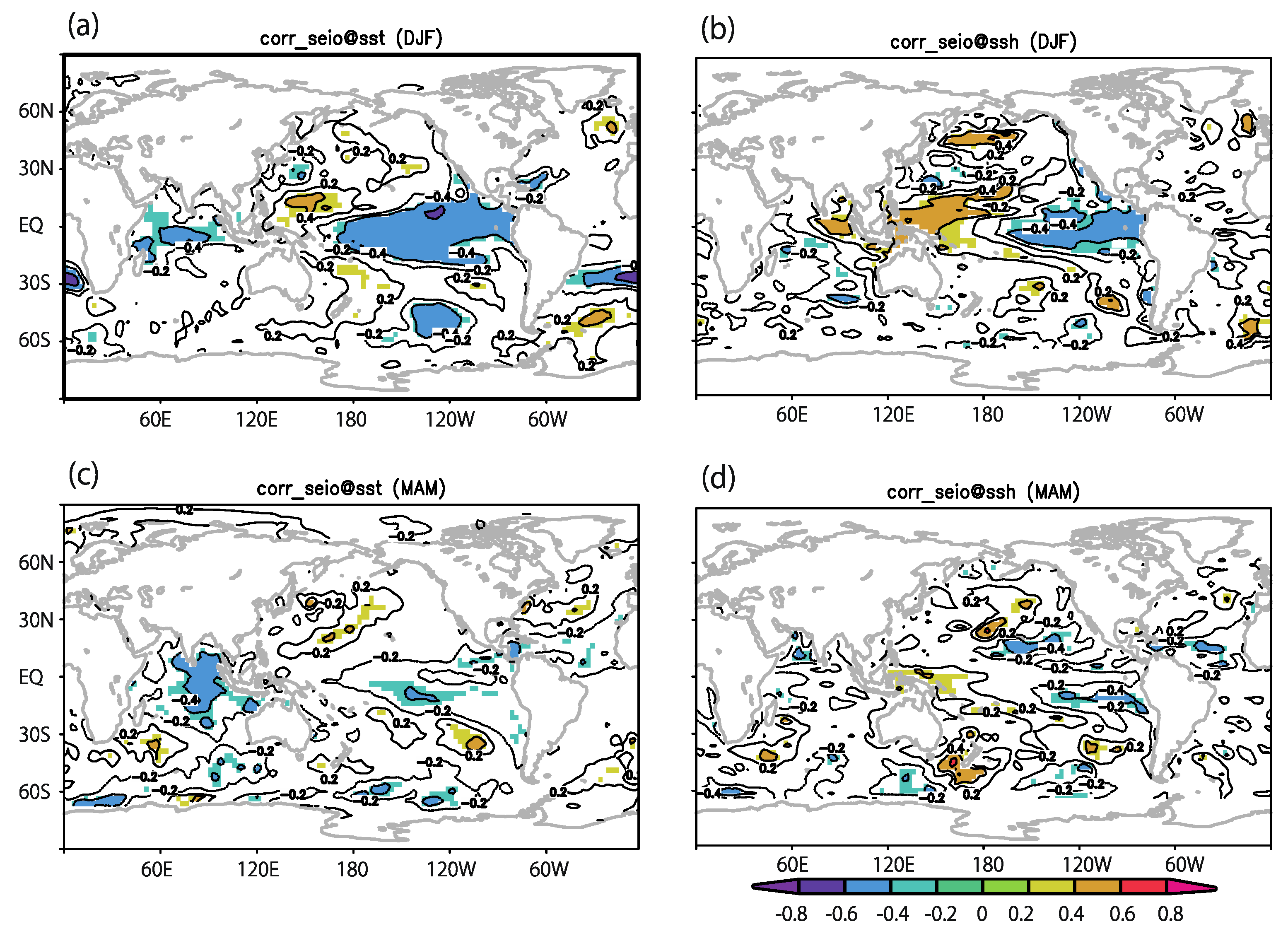
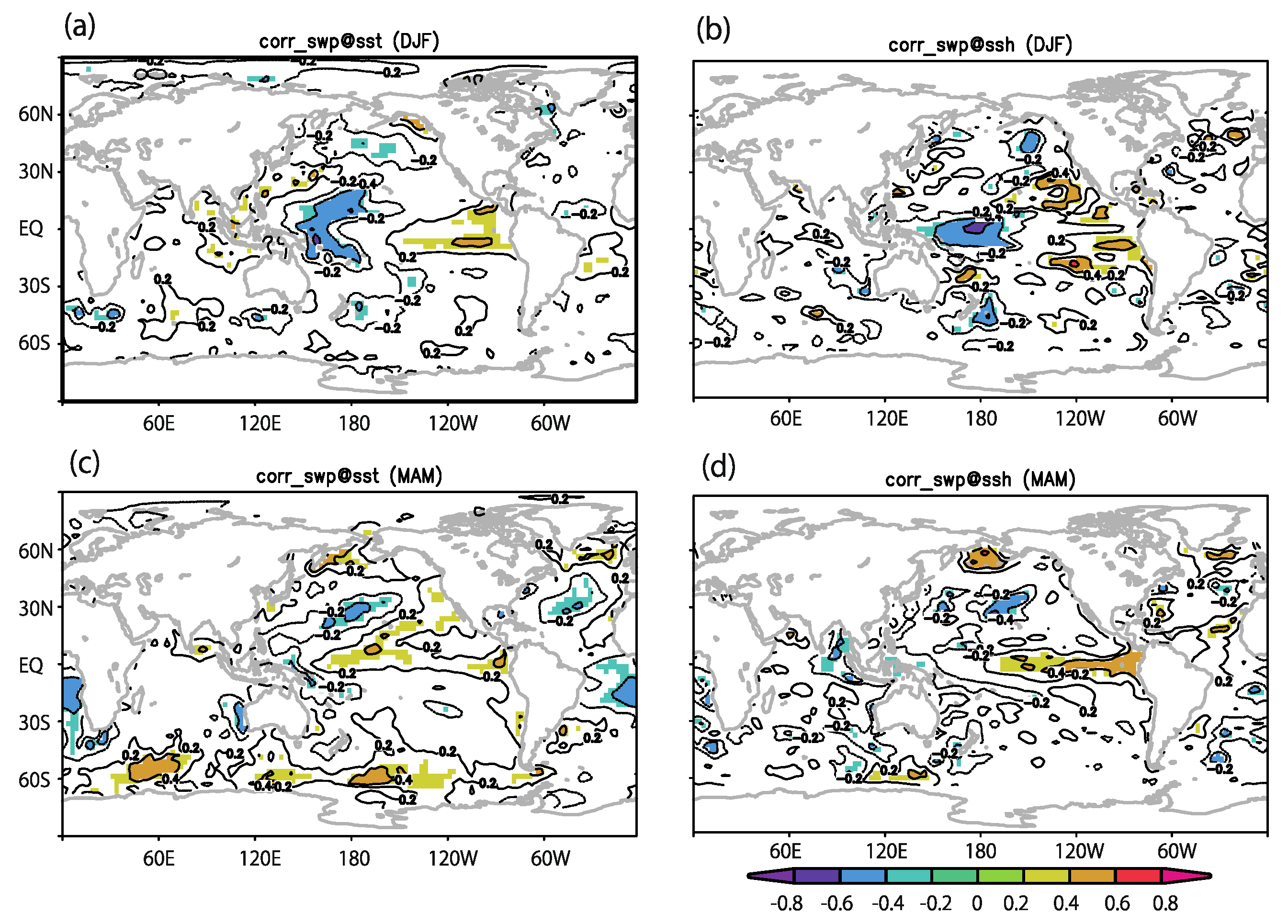

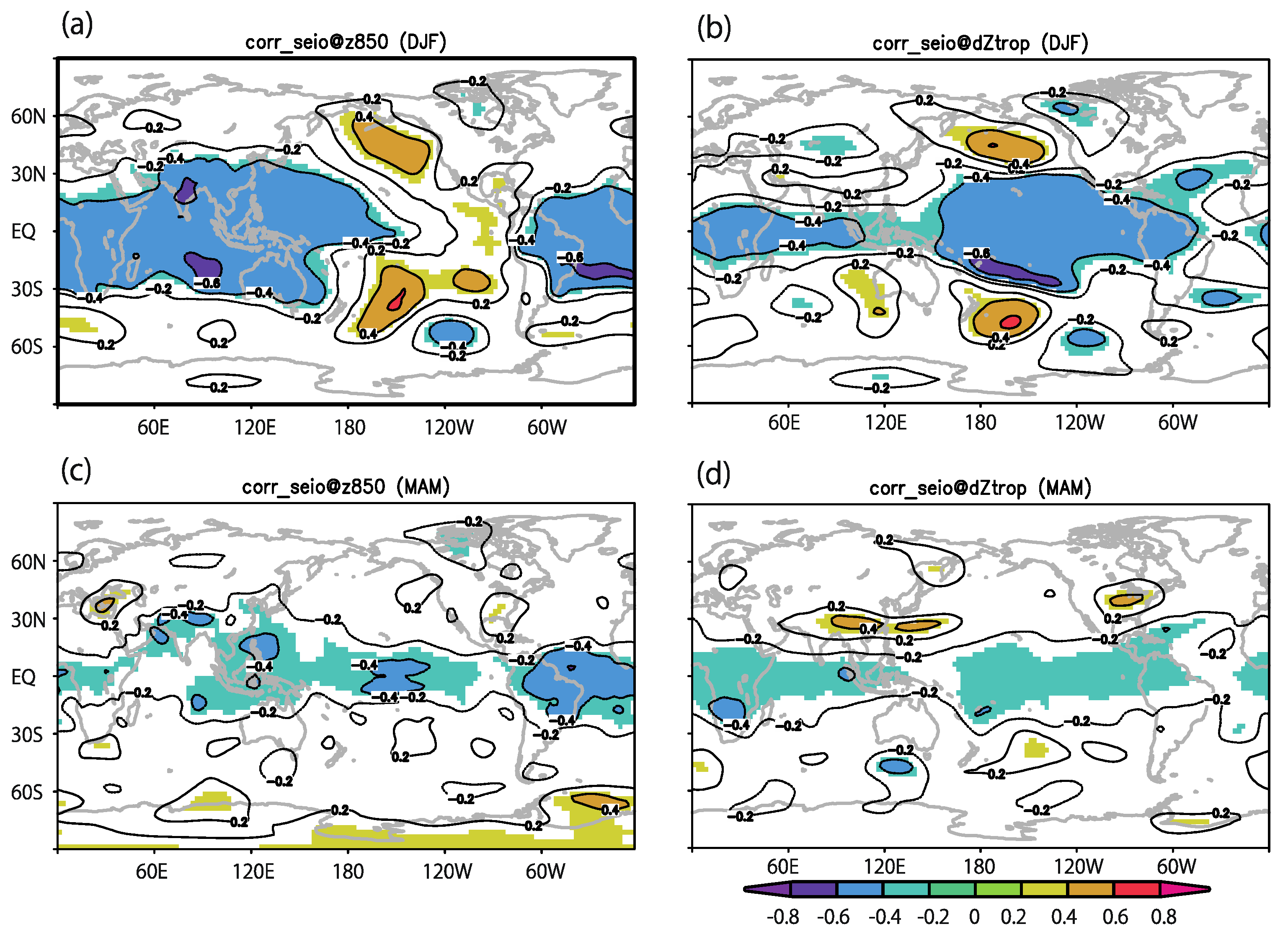
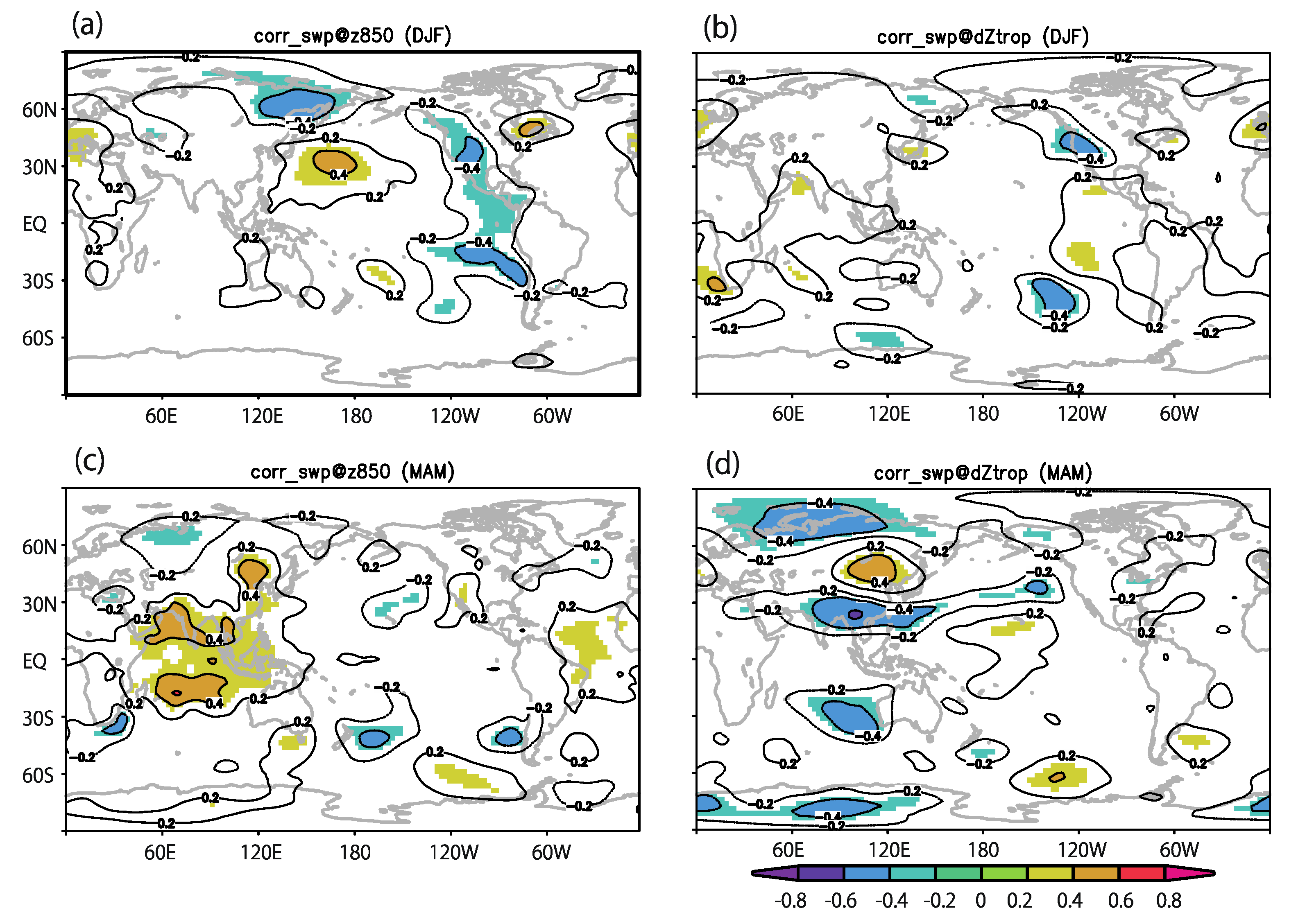
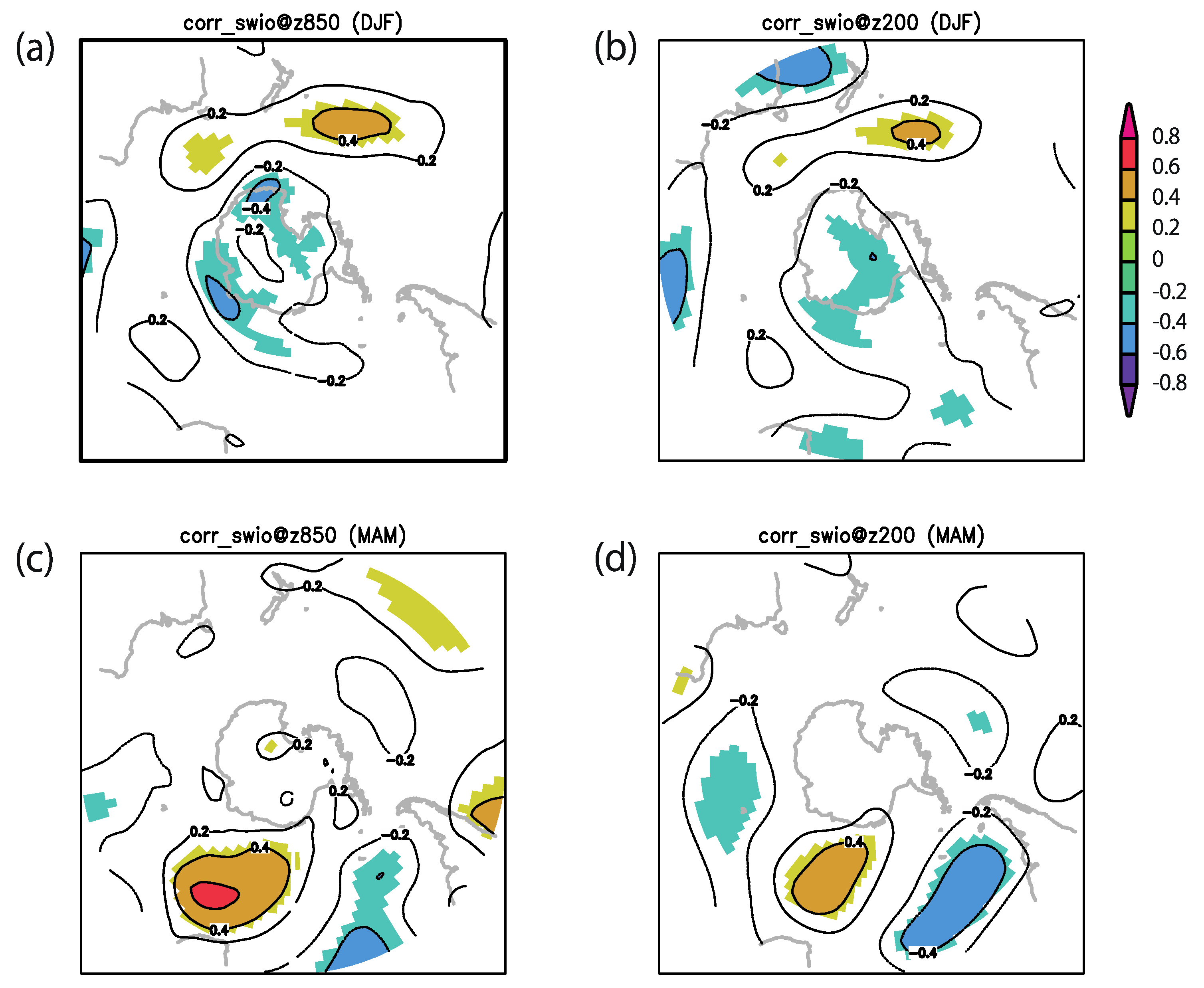
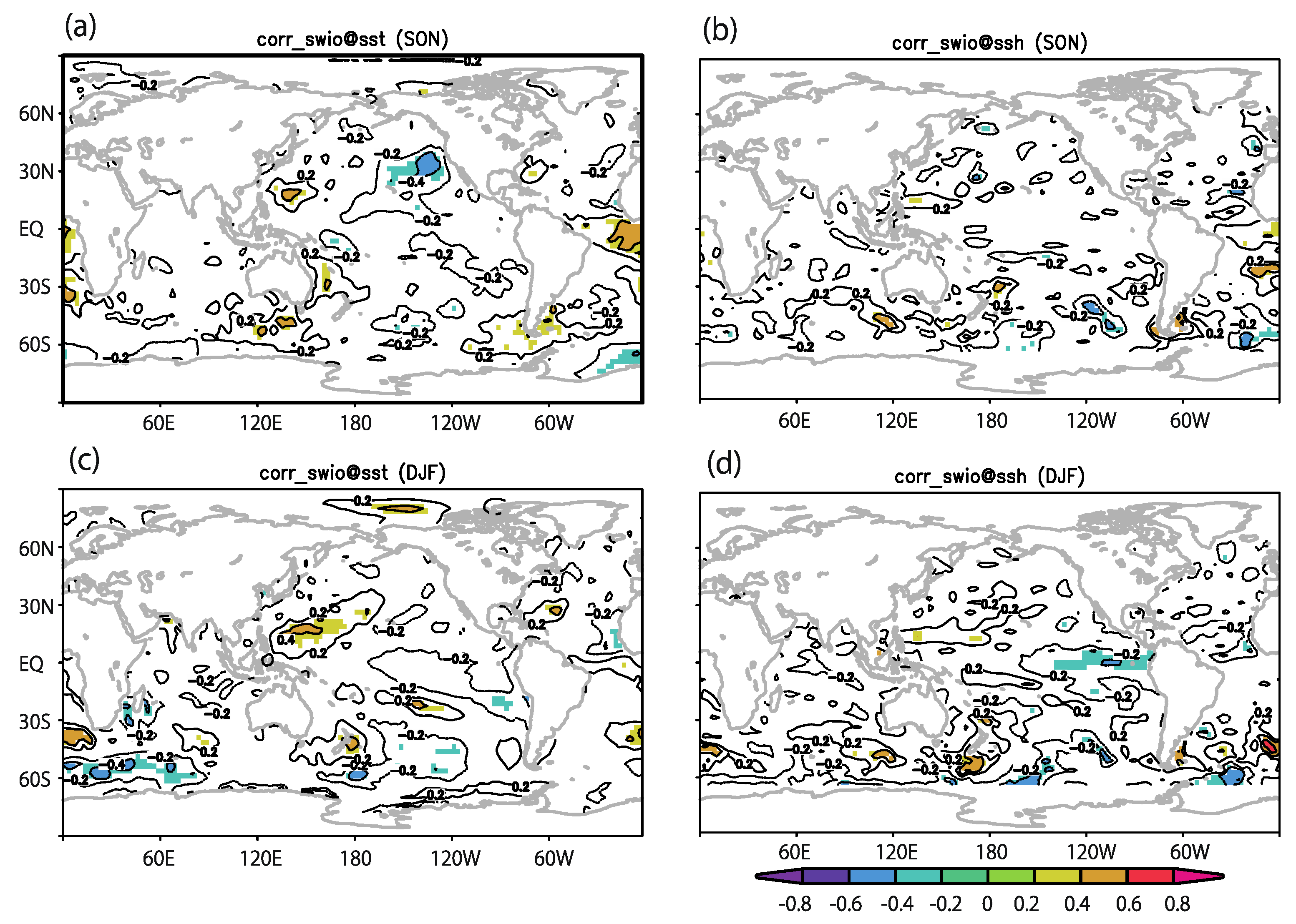
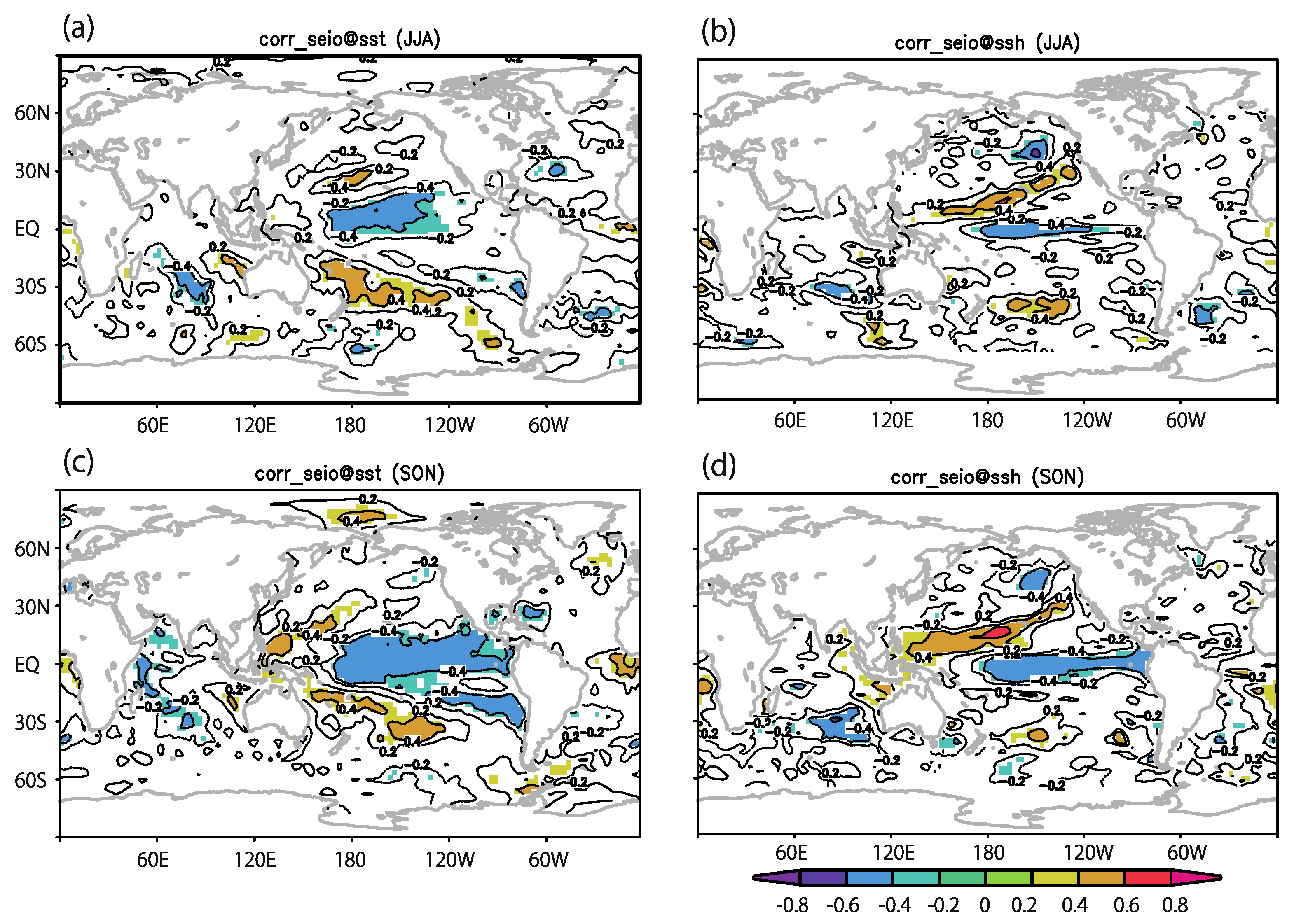

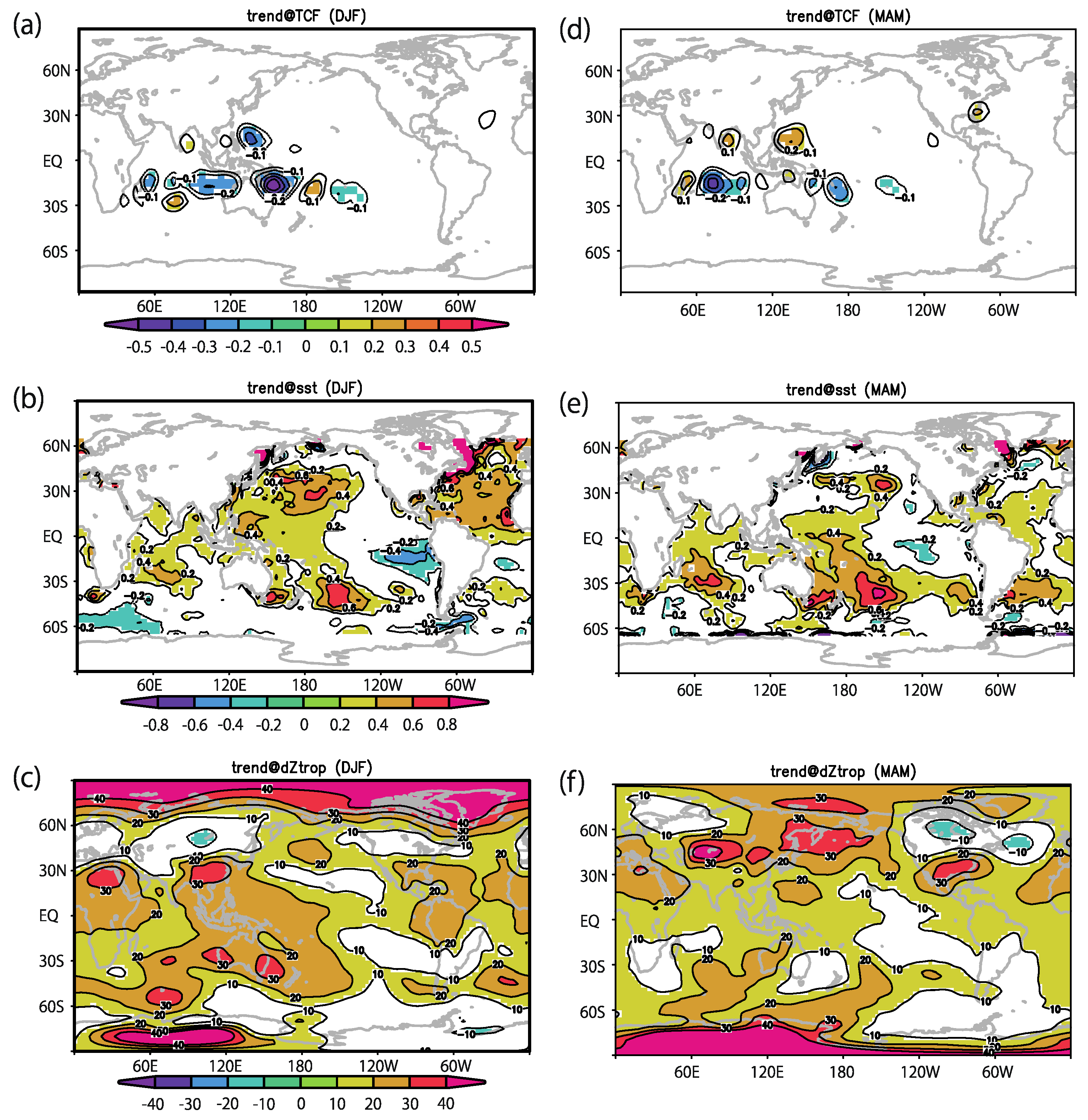
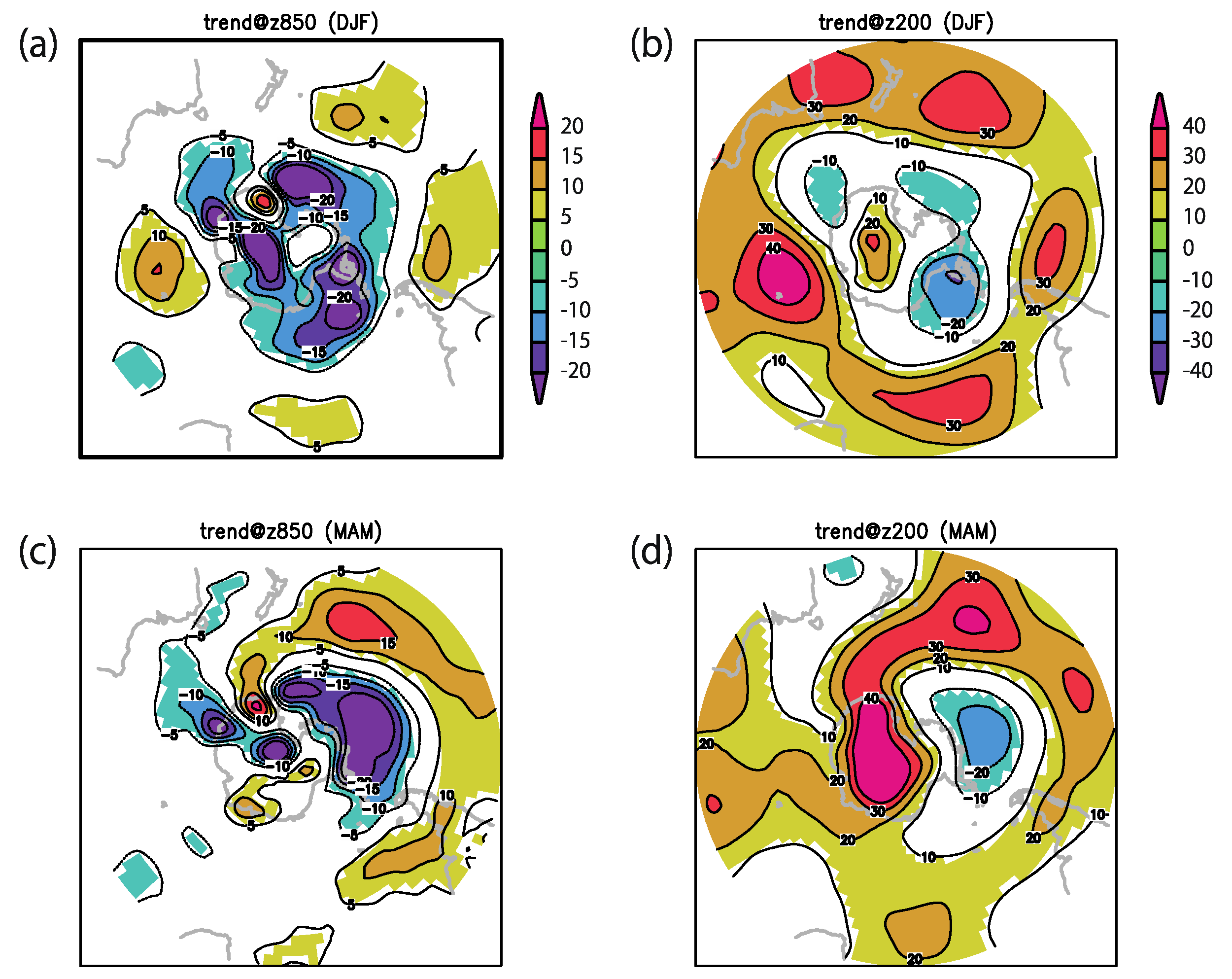

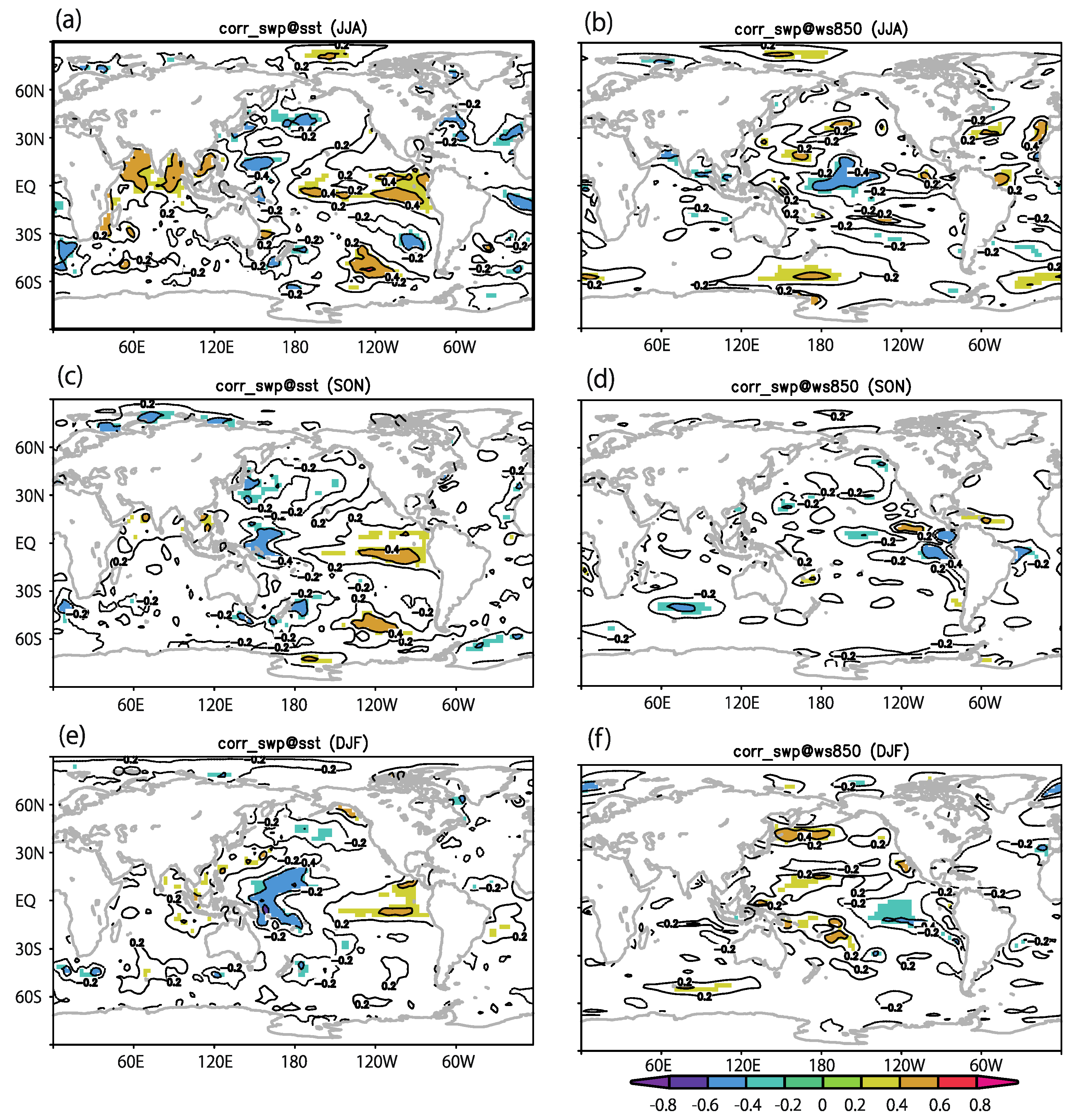
| Vort850 | RH600 | MPI | Ushear | |
|---|---|---|---|---|
| SWIO-DJF | 0.46 | 0.55 | −0.47 | −0.4 |
| SEIO-DJF | 0.51 | 0.55 | −0.05 | 0.14 |
| SWP-DJF | 0.3 | 0.07 | −0.37 | −0.04 |
| SWIO-MAM | 0.006 | −0.019 | −0.41 | 0.35 |
| SEIO-MAM | 0.38 | 0.05 | −0.38 | 0.26 |
| SWP-MAM | 0.48 | −0.21 | −0.32 | −0.23 |
| Niño-3 | EMI | DMI | |
|---|---|---|---|
| SWIO-DJF | −0.36/−0.31/−0.31 | −0.04/−0.09/−0.13 | 0.03/0.11/0.12 |
| SWIO-MAM | −0.4/−0.23/−0.17 | 0.13/−0.14/−0.16 | 0.3/0.18/0.13 |
| SEIO-DJF | −0.55/−0.47/−0.26 | −0.35/−0.42/−0.41 | −0.18/−0.27/−0.05 |
| SEIO-MAM | −0.3/−0.37/−0.4 | −0.1/−0.18/−0.08 | 0.26/−0.17/−0.26 |
| SWP-DJF | 0.28/0.33/0.37 | −0.24/−0.18/−0.1 | −0.2/0.08/0.1 |
| SWP-MAM | 0.25/0.09/0.11 | 0.1/0.23/0.12 | −0.06/0.29/−0.16 |
Disclaimer/Publisher’s Note: The statements, opinions and data contained in all publications are solely those of the individual author(s) and contributor(s) and not of MDPI and/or the editor(s). MDPI and/or the editor(s) disclaim responsibility for any injury to people or property resulting from any ideas, methods, instructions or products referred to in the content. |
© 2023 by the author. Licensee MDPI, Basel, Switzerland. This article is an open access article distributed under the terms and conditions of the Creative Commons Attribution (CC BY) license (https://creativecommons.org/licenses/by/4.0/).
Share and Cite
Ogata, T. Seasonality of Relationship between Tropical Cyclone Frequency over the Southern Hemisphere and Tropical Climate Modes. Atmosphere 2023, 14, 546. https://doi.org/10.3390/atmos14030546
Ogata T. Seasonality of Relationship between Tropical Cyclone Frequency over the Southern Hemisphere and Tropical Climate Modes. Atmosphere. 2023; 14(3):546. https://doi.org/10.3390/atmos14030546
Chicago/Turabian StyleOgata, Tomomichi. 2023. "Seasonality of Relationship between Tropical Cyclone Frequency over the Southern Hemisphere and Tropical Climate Modes" Atmosphere 14, no. 3: 546. https://doi.org/10.3390/atmos14030546
APA StyleOgata, T. (2023). Seasonality of Relationship between Tropical Cyclone Frequency over the Southern Hemisphere and Tropical Climate Modes. Atmosphere, 14(3), 546. https://doi.org/10.3390/atmos14030546







